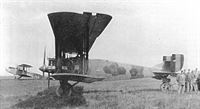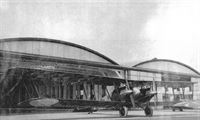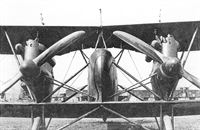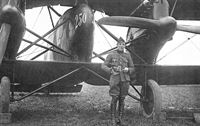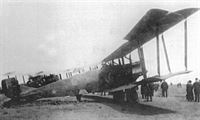
Описание
Страна: Германия
Год: 1918
O.Thetford, P.Gray German Aircraft of the First World War (Putnam)
Gotha G IX
The Gotha G IX was not built by the parent firm, but by L.V.G. Little information is available, and it is doubtful if more than one or two machines were built before the war ended. Engines, two 245 h.p. Maybach Mb IV.
Gotha G X
Apart from the fact that it was powered with two 180 h p B M W IIIa engines, no details are available of this small twin-engined machine although it is believed to have been intended as a faster photographic and reconnaissance aircraft.
Описание:
- O.Thetford, P.Gray German Aircraft of the First World War (Putnam)
- J.Herris Gotha Aircraft of WWI (A Centennial Perspective on Great War Airplanes 6)
Фотографии
-
J.Herris - Gotha Aircraft of WWI /Centennial Perspective/ (6)
Gotha G.IX(LVG) in Postwar Belgian Service
-
J.Herris - Gotha Aircraft of WWI /Centennial Perspective/ (6)
This Gotha G.IX(LVG) illustrates the extended wing-span of this version of the GL series. A British crew attempted to fly this aircraft back to Britain, but it crashed when leaving Bickendorf and the crew was killed.
-
J.Herris - Gotha Aircraft of WWI /Centennial Perspective/ (6)
Gotha G.IX(LVG) G.263/18 displays the LVG-style markings and is armed with a PuW bomb under the fuselage.
-
J.Herris - Gotha Aircraft of WWI /Centennial Perspective/ (6)
Gotha G.IX(LVG) G.257/18 is covered in dark, printed camouflaged fabric.
-
J.Herris - Gotha Aircraft of WWI /Centennial Perspective/ (6)
The Gotha G.IX(LVG) in this postwar view has no visible markings other than the Belgian colors on the rudders, but its hexagonal camouflage fabric is well illustrated.The aileron aerodynamic balances have slots, but the aerodynamic balances on the rudders do not. A DH.9 is visible in the background.
Другие самолёты на фотографии: De Havilland D.H.9 - Великобритания - 1917
-
J.Herris - Gotha Aircraft of WWI /Centennial Perspective/ (6)
This Gotha G.IX(LVG) illustrates the type's clean lines. It is serving in Belgium postwar.The number '250' on the nose may indicate it is serial G.250/18, but there is no confirmation. Roundels are being painted under the wings but are not yet complete. The aircraft is covered in dark, printed camouflage fabric.
-
J.Herris - Gotha Aircraft of WWI /Centennial Perspective/ (6)
Gotha G.IX(LVG) in Belgian service postwar. These views illustrate details and emphasize the aerodynamic lines of the GL series. Problems of propeller selection for maximum ceiling and speed at altitude, always a challenge with fixed-pitch propellers, prolonged development of the GL-series.
-
J.Herris - Gotha Aircraft of WWI /Centennial Perspective/ (6)
The front gunner position was eliminated in the Gotha GL designs to save weight and drag; the bomber depending on speed and its rear gunner for protection. Put into limited production, the GL.IX (shown) was too late to reach operational units before the armistice. Twenty were delivered to Belgium after the war as reparations, where this one was photographed.
-
J.Herris - Gotha Aircraft of WWI /Centennial Perspective/ (6)
Gotha G.IX(LVG) in Belgian service postwar.
-
J.Herris - Gotha Aircraft of WWI /Centennial Perspective/ (6)
Gotha G.IX(LVG) in Belgian service postwar.
-
J.Herris - Gotha Aircraft of WWI /Centennial Perspective/ (6)
Gotha G.IX(LVG) in Belgian service postwar.
-
W.Pieters - The Belgian Air Service in the First World War /Aeronaut/
A Gotha G.IX in Belgian markings rests on the field at Evere, 1919.
This Gotha G.IX(LVG) 299/18 illustrates its LVG-style markings, its camouflage fabric, and the fairings over the radiators in the upper wing above the engines. -
J.Herris - Gotha Aircraft of WWI /Centennial Perspective/ (6)
Gotha G.IX(LVG) serving in Belgium postwar illustrates the type's clean lines. It appears to be on public display. A Friedrichshafen bomber is in the background.
Другие самолёты на фотографии: Friedrichshafen G.I/G.II/G.III (FF30/FF38/FF45) - Германия - 1915
-
J.Herris - Gotha Aircraft of WWI /Centennial Perspective/ (6)
Gotha GL.IX in Belgium postwar.
-
J.Herris - Gotha Aircraft of WWI /Centennial Perspective/ (6)
The Gotha G.X prototype had two-bay wings and was powered by two 185 hp BMW.IIIa engines. Somehow this airframe and engine combination was supposed to excel as both a high-altitude reconnaissance aircraft and a low-level ground-attack aircraft, seemingly contradictory requirements. The massive WD27 looms in the background.
Другие самолёты на фотографии: Gotha WD.27 - Германия - 1918
-
M.Dusing - German Aviation Industry in WWI. Volume 1 /Centennial Perspective/ (84)
The last Gotha developments before the end of the war: Gotha WD 27 on floats, left Bomber Go.X with undercarriage.
Другие самолёты на фотографии: Gotha WD.27 - Германия - 1918





